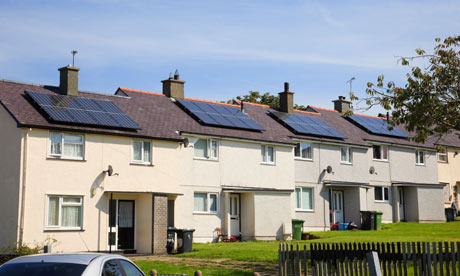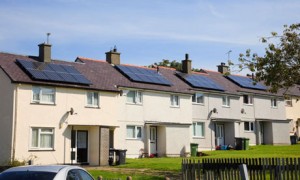Are you a homeowner with some spare cash? A 20%-25% collapse in the price of rooftop solar power units in recent months has turned the government’s feed-in tariff scheme into one of the most lucrative financial propositions for households with the right sort of property.
The scheme was introduced in April 2010, when the Labour government introduced generous feed-in tariffs to encourage households to install solar photovoltaic systems. Back then, anyone spending, say, £13,000 up front to fit a 2.5kWp system to their home was paid 41.3p per kilowatt hour (kWh) generated – enough to earn them a typical annual income of £900 a year in payments, on top of a £140-a-year saving in reduced electricity bills.

It was described as a good investment because payments for each unit of electricity generated were guaranteed for 25 years, paid tax-free, and set to rise each year in line with inflation.
If you were planning to stay in your home and had a suitable roof (unshaded, at a pitch of about 40 degrees, and facing between south-east and south-west), the main question was how big a system to install – assuming you could raise the installation costs. The bigger the system, the greater the financial return.
However, you shouldn’t worry if you put off doing anything because it has emerged this week that waiting has worked in your favour.
Solar experts say that as a result of the installation costs coming down, the investment value of the scheme has become even better. These lower installation costs, an inflation-linked increase to the feed-in tariff payments and the prospect of rising electricity prices all mean the guaranteed returns are now above 10% a year, depending on how you calculate it. And if you install before next April – when new payment tariffs look set to come into force – you are guaranteed the tariffs for the next 25 years at the old rate.
Gabriel Wondrausch, who set up Exeter-based PV installer Sun Gift Solar, says the cost of systems has come down dramatically in 18 months. “We’ve been supplying PV systems for almost five years now and the prices have been on an almost continuous downward path,” he says. “A year ago we were selling a large 4kWp system for around £16,000. Today that same one is costing less than £13,000.” (Two years ago the cost would have been closer to £20,000.)
Wondrausch says the volume of sales has been a major factor in UK prices coming down, as has the reduction of feed-in tariffs in Germany, Europe’s biggest PV market. The panel manufacturers, it seems, price their panels according to the returns consumers can expect, and have been lowering prices as a result.
Solarcentury, one of the UK’s biggest solar companies, confirms the view that prices are falling. And even British Gas has reduced the price of its PV systems. A spokesman says business efficiencies and efficiencies in the supply chain mean costs have fallen by about 20% since June last year. “A typical 2.5kWp system cost around £13,383 last year,” he says. “Today it would cost around £10,450. We also need to consider that panel efficiency has increased – panels are 10% more efficient than they were.”
Wondrausch points out that the generous tariffs won’t be around for ever. In September the government is expected to unveil a new – significantly less generous – scheme for those installing PV systems after April 2012, suggesting that if you want to do it, now is the time to act.
Originally, it was thought the payments for new installations would be cut by 9% from their current level of 43.3p per kWh generated.
Solarcentury says the industry is currently awaiting publication of the government’s proposals for tariff cuts. “There is no doubt that the proposed cut for new installations from April 2012 will be higher than the planned 9%,” it predicts.
Meanwhile, if you are thinking of installing a system be prepared to spend some time researching the company you are using to carry out the work.
Cathy Debenham, who runs website YouGen.co.uk, says there is growing evidence of dubious sales tactics in the solar PV market. She recently came across one company that claimed you could make money by installing a panel on a north-facing roof, which is nonsense. The consumer group Which? warned that some claims made by firms selling solar PV could not be substantiated. Its advice is that consumers should be wary of any company that offers a quote without visiting the home to carry out a proper survey, or one that makes grandiose claims about the income you will receive.
Debenham’s site is a good starting point if you’re looking for information, or for a good installer who comes with recommendations from other users. The Energy Saving Trust site has lots of information too.
One thing to ask your chosen installer is which panels they plan to use. Wondrausch, who was one of the first to install PV panels in the UK five years ago, says the panels vary significantly in the electricity they produce – by as much as 12.5%.

 Follow
Follow